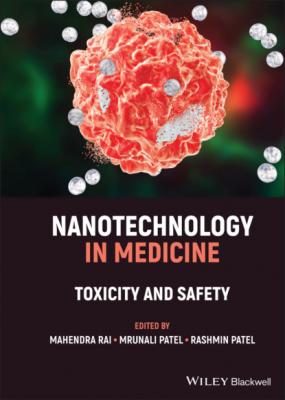Nanotechnology in Medicine. Группа авторов
Чтение книги онлайн.
Читать онлайн книгу Nanotechnology in Medicine - Группа авторов страница 9
 style="font-size:15px;"> 423 417
style="font-size:15px;"> 423 417424 418
425 419
426 420
427 421
428 422
429 423
430 424
431 425
Nanotechnology in Medicine
Toxicity and Safety
Edited by
Mahendra Rai
Sant Gadge Baba Amravati University Maharashtra, India
Mrunali Patel
Ramanbhai Patel College of Pharmacy, Charotar University of Science and Technology Changa, Gujarat, India
Rashmin Patel
Ramanbhai Patel College of Pharmacy, Charotar University of Science and Technology Changa, Gujarat, India
This edition first published 2022
© 2022 John Wiley & Sons Ltd
All rights reserved. No part of this publication may be reproduced, stored in a retrieval system, or transmitted, in any form or by any means, electronic, mechanical, photocopying, recording or otherwise, except as permitted by law. Advice on how to obtain permission to reuse material from this title is available at http://www.wiley.com/go/permissions.
The right of Mahendra Rai, Mrunali Patel, and Rashmin Patel, to be identified as the authors of the editorial material in this work has been asserted in accordance with law.
Registered Offices John Wiley & Sons, Inc., 111 River Street, Hoboken, NJ 07030, USA John Wiley & Sons Ltd, The Atrium, Southern Gate, Chichester, West Sussex, PO19 8SQ, UK
Editorial Office 9600 Garsington Road, Oxford, OX4 2DQ, UK For details of our global editorial offices, customer services, and more information about Wiley products visit us at www.wiley.com.
Wiley also publishes its books in a variety of electronic formats and by print‐on‐demand. Some content that appears in standard print versions of this book may not be available in other formats.
Limit of Liability/Disclaimer of Warranty The contents of this work are intended to further general scientific research, understanding, and discussion only and are not intended and should not be relied upon as recommending or promoting scientific method, diagnosis, or treatment by physicians for any particular patient. In view of ongoing research, equipment modifications, changes in governmental regulations, and the constant flow of information relating to the use of medicines, equipment, and devices, the reader is urged to review and evaluate the information provided in the package insert or instructions for each medicine, equipment, or device for, among other things, any changes in the instructions or indication of usage and for added warnings and precautions. While the publisher and authors have used their best efforts in preparing this work, they make no representations or warranties with respect to the accuracy or completeness of the contents of this work and specifically disclaim all warranties, including without limitation any implied warranties of merchantability or fitness for a particular purpose. No warranty may be created or extended by sales representatives, written sales materials or promotional statements for this work. The fact that an organization, website, or product is referred to in this work as a citation and/or potential source of further information does not mean that the publisher and authors endorse the information or services the organization, website, or product may provide or recommendations it may make. This work is sold with the understanding that the publisher is not engaged in rendering professional services. The advice and strategies contained herein may not be suitable for your situation. You should consult with a specialist where appropriate. Further, readers should be aware that websites listed in this work may have changed or disappeared between when this work was written and when it is read. Neither the publisher nor authors shall be liable for any loss of profit or any other commercial damages, including but not limited to special, incidental, consequential, or other damages.
Library of Congress Cataloging‐in‐Publication Data Names: Rai, Mahendra, editor. | Patel, Mrunali Rashmin, 1981– editor. | Patel, Rashmin Bharatbhai, 1979– editor. Title: Nanotechnology in medicine : toxicity and safety / edited by Mahendra Kumar Rai, SGB Amravati University, Maharashtra, India, Mrunali Rashmin Patel, Charotar University of Science and Technology, Gujarat, India, Rashmin Bharatbhai Patel, Charotar University of Science and Technology, Gujarat, India. Description: Hoboken, NJ : Wiley–Blackwell, 2022. | Includes bibliographical references and index. Identifiers: LCCN 2021031539 (print) | LCCN 2021031540 (ebook) | ISBN 9781119769866 (cloth) | ISBN 9781119769873 (adobe pdf) | ISBN 9781119769880 (epub) Subjects: LCSH: Nanotechnology. | Medical technology. Classification: LCC R857.N34 N3617 2022 (print) | LCC R857.N34 (ebook) | DDC 610.285–dc23 LC record available at https://lccn.loc.gov/2021031539 LC ebook record available at https://lccn.loc.gov/2021031540
Cover Design: Wiley
Cover Image: © KATERYNA KON/Getty
Preface
Currently, an exceptional growth in research, innovation, and applications have been realized in the area of nanoscience and nanotechnology. Nanotechnology is beheld as a transformative technology. It offers ample possibilities to address the key societal challenges essential to encounter global healthcare problems. It presents engineered nanomaterials, smart innovative products incorporating these materials, and nanoenabled processes having magnificent growth potential for a large number of industrial sectors. Formulation scientists have extensively used nanoparticles for entrapment of drugs with intention of enhanced delivery to, or uptake by, target cells and/or a reduction in the toxicity of the free drug to nontarget organs. There is collective optimism that nanotechnology, as applied to medicine, has and will further lead to noteworthy developments in therapeutics, tissue engineering, active implants, nano‐robotic biosensors, molecular diagnostics and imaging, bone grafting, tiny vehicles for drug delivery, nutraceuticals, genomics, and proteomics. Nanomedicine, incorporating prospective drug delivery nanocarriers, hails great promises to combat complex illnesses like cancer, neurological diseases, infectious or inflammatory diseases, and malaria due to novel physicochemical properties. However, this may damage and exert toxicological effects due to detrimental interfaces with living systems and the environment. Thus, the smart and sustainable development of these nanomaterials has created concerns about their possible undesirable effects on human health and safety as well as an environmental burden. Additionally, these necessitate